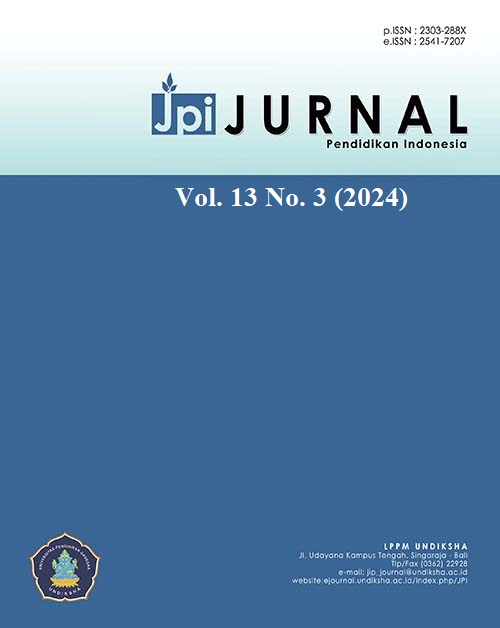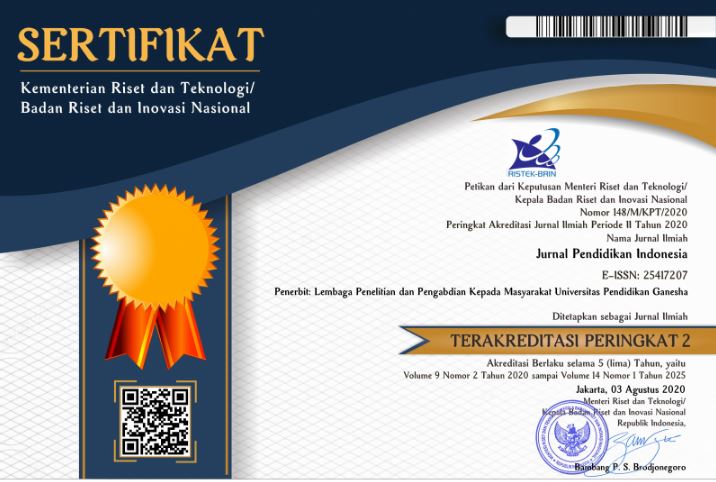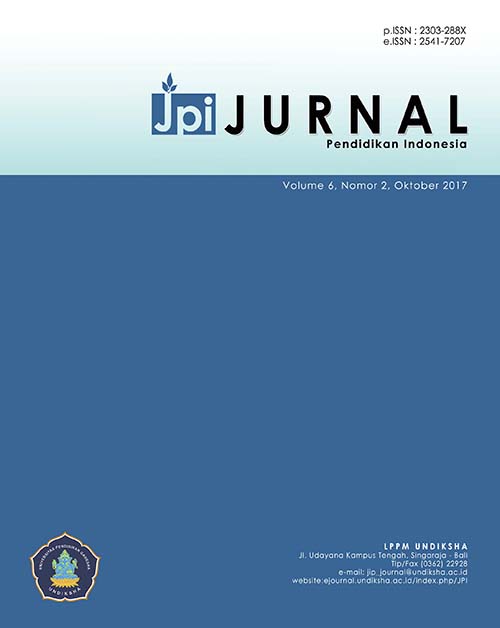Uncovering the Needs for a Web-based Sign Language Model for Deaf Students with American Sign Language (ASL)
DOI:
https://doi.org/10.23887/jpiundiksha.v13i3.68857Kata Kunci:
Need Analysis, Deaf, Sign LanguageAbstrak
Inclusive education is the right of every individual, including deaf students, to have equal access to English language learning. This research aims to develop a prototype of a web-based sign language learning model, using American Sign Language (WEBSL), for deaf students in learning English. This research uses a Research and Development (R&D) approach with the ADDIE development model. The subject of the study involved 25 deaf students from one of the Special Schools (SLB) in Pontianak City. Data was collected through analysis of the content of English textbooks tailored to deaf students, as well as thematic interviews with experienced teachers, to identify students' learning needs that included inclusivity, accessibility, language clarity, and visual learning preferences. The results of the analysis show the need for an interactive web-based learning model to facilitate deaf students' access to customized English language materials. The prototype developed in this study is designed to suit needs, be interactive, easily accessible, and take into account cultural sensitivities. The conclusion of this study emphasizes the importance of developing adaptive and interactive learning resources, as well as their implications for improving the English skills of deaf students.
Referensi
Ackerman, J. M., Wolsey, J. L. A., & Clark, M. D. (2018). Locations of L2/Ln sign language pedagogy. Creative Education, 9(13), 2037–2058. https://doi.org/10.4236/ce.2018.913148.
Ainscow, M. (2020). Promoting inclusion and equity in education: lessons from international experiences. Nordic Journal of Studies in Educational Policy, 6(1), 7–16. https://doi.org/10.1080/20020317.2020.1729587
Al-Dababneh, K. A., & Al-Zboon, E. K. (2022). Using assistive technologies in the curriculum of children with specific learning disabilities served in inclusion settings: teachers’ beliefs and professionalism. Disability and Rehabilitation: Assistive Technology, 17(1), 23–33. https://doi.org/10.1080/17483107.2020.1752824.
Astuti, E. Y., Ratnawulan, T., Santoso, Y. B., Pertiwi, D. E., Ridwan, P. G., & Effendi, Z. R. (2023). The Interactive Web-Based Learning in Online Learning for Blind Students and Deaf Students in Higher Education. Journal of ICSAR, 7(1), 171–177. https://doi.org/10.17977/um005v7i12023p171.
Birinci, F. G., & Saricoban, A. (2021). The effectiveness of visual materials in teaching vocabulary to deaf students of EFL. Journal of Language and Linguistic Studies, 17(1), 628–645. https://doi.org/10.52462/jlls.43.
Branch, R. M., & Kopcha, T. J. (2014). Instructional design models. In Handbook of research on educational communications and technology (pp. 77–87).
Brown, P. M., & Byrnes, L. J. (2014). The Development and Use of Individual Learning Plans for Deaf and Hard of Hearing Students in Victoria, Australia. Deafness & Education International, 16(4), 204–217. https://doi.org/10.1179/1557069X13Y.0000000034.
Canale, G. (2016). (Re) Searching culture in foreign language textbooks, or the politics of hide and seek. Language, Culture and Curriculum, 29(2), 225–243. https://doi.org/10.1080/07908318.2016.1144764.
Chen, Y. (2014). The application of multimedia computer assisted language learning in English teaching. Advanced Materials Research, 926, 4634–4637. https://doi.org/10.4028/www.scientific.net/AMR.926-930.4634.
Clark, M. D., & Lee, C. M. (2018). Culture in L2/ln sign language pedagogy. Creative Education, 9(13), 1897–1909. https://doi.org/10.4236/ce.2018.913139.
Drajati, N. A., Ikasari, B., & Junhita, R. (2021). Hard-of-Hearing (HH) Students’ Perceptions of Multimodal EFL Learning. Langkawi: Journal of The Association for Arabic and English, 7(1), 40–50. https://doi.org/10.31332/lkw.v7i1.2449.
Fernández-Batanero, J. M., Montenegro-Rueda, M., Fernández-Cerero, J., & García-Martínez, I. (2022). Assistive technology for the inclusion of students with disabilities: a systematic review. Educational Technology Research and Development, 70(5), 1911–1930. https://doi.org/10.1007/s11423-022-10127-7.
Fitriyani, F., Ainii, L. Q., Jannah, R., & Maryam, S. (2024). Analysis of Sign Language Skills in Improving Communication and Learning for Deaf Children. Continuous Education: Journal of Science and Research, 5(1), 30–39. https://doi.org/10.51178/ce.v5i1.1757.
González, L. F. M., & Quiroz, V. G. (2019). Instructional design in online education: A systemic approach. European Journal of Education, 2(3), 43–52. https://doi.org/10.26417/ejed.v2i3.p64-73.
Hankebo, T. A. (2018). Being a Deaf and a Teacher: Exploring the Experiences of Deaf Teachers in Inclusive Classrooms. International Journal of Instruction, 11(3), 477–490. https://doi.org/10.12973/iji.2018.11333a.
Hariyadi, A., & Yanti, D. R. (2019). The Importance Of Needs Analysis In Materials Development. Jurnal Ilmiah Profesi Pendidikan, 4(2), 94–99. https://doi.org/10.29303/jipp.v4i2.88.
Higgins, M., & Lieberman, A. M. (2016). Deaf Students as a Linguistic and Cultural Minority: Shifting Perspectives and Implications for Teaching and Learning. Journal of Education, 196(1), 9–18. https://doi.org/10.1177/002205741619600103.
Ikasari, B., Drajati, N. A., & Sumardi, S. (2019). The Use of Multi-modal Texts in An English Classroom of Hard-of- Hearing Learners. Pedagogy: Journal of English Language Teaching, 7(2), 95–103. https://doi.org/10.32332/pedagogy.v7i2.1661.
Jayanegara, I. N., Setiawan, I. N. A. F., & Putri, G. A. M. (2020). Design of Interactive Multimedia Learning Vocabulary for Students Communication Disorder and Deafness During the Covid-19 Pandemic. Indonesian Journal of Disability Studies, 7(2), 239–248. https://doi.org/10.21776/ub.ijds.2020.007.02.12.
Jenkins, J., & Rashad, S. (2022). LeapASL: A platform for design and implementation of real time algorithms for translation of American Sign Language using personal supervised machine learning models. Software Impacts, 12, 100302. https://doi.org/10.1016/j.simpa.2022.100302.
Keles, U., & Yazan, B. (2023). Representation of cultures and communities in a global ELT textbook: A diachronic content analysis. Language Teaching Research, 27(5), 1325–1346. https://doi.org/10.1177/1362168820976922.
Kermit, P. S. (2019). Passing for recognition – deaf children’s moral struggles languaging in inclusive education settings. Deafness & Education International, 21(2–3), 116–132. https://doi.org/10.1080/14643154.2018.1561783.
Kožuh, I., Hintermair, M., & Debevc, M. (2016). Community building among deaf and hard of hearing people by using written language on social networking sites. Computers in Human Behavior, 65, 295–307. https://doi.org/10.1016/j.chb.2016.08.035.
Kusters, A. (2020). The tipping point: On the use of signs from American Sign Language in International Sign. Language & Communication, 75, 51–68. https://doi.org/10.1016/j.langcom.2020.06.004.
Kusters, A. (2021). International Sign and American Sign Language as Different Types of Global Deaf Lingua Francas. Sign Language Studies, 21(4), 391–426. https://doi.org/10.1353/sls.2021.0005.
Kusters, A., & Lucas, C. (2021). Emergence and evolutions: Introducing sign language sociolinguistics. Sign Language Studies, 22(2), 320–342. https://doi.org/10.1353/sls.2021.0023.
Lynch, P., Singal, N., & Francis, G. A. (2024). Educational technology for learners with disabilities in primary school settings in low-and middle-income countries: a systematic literature review. Educational Review, 76(2), 405–431. https://doi.org/10.1080/00131911.2022.2035685.
Masykar, T., & Nurrahmi, F. (2020). Motivation and satisfaction towards two-year vocational diploma. Jurnal Pendidikan Vokasi, 10(1), 10–21. https://doi.org/10.21831/jpv.v10i1.30123.
McNicholl, A., Casey, H., Desmond, D., & Gallagher, P. (2021). The impact of assistive technology use for students with disabilities in higher education: a systematic review. Disability and Rehabilitation: Assistive Technology, 16(2), 130–143. https://doi.org/10.1080/17483107.2019.1642395.
Medina, B. L. (2016). Developing a CLIL textbook evaluation checklist. Latin American Journal of Content & Language Integrated Learning, 9(1), 159–173. https://doi.org/10.5294/6016.
Moriarty, E. (2020). “Sign to me, not the children”: Ideologies of language contamination at a deaf tourist site in Bali. Language & Communication, 74, 195–203. https://doi.org/10.1016/j.langcom.2020.06.002.
Mubar, M. K. N. A. (2015). Developing English learning materials for young learners based on needs analysis at MTSN model Makassar. ETERNAL (English, Teaching, Learning, and Research Journal), 1(2), 313–330. https://doi.org/10.24252/Eternal.V12.2015.A8.
Mustofa, M. I., & Martina, F. (2019). The Analysis of Cultural Content in Two EFL Textbooks Used at SMA IT Iqra’ And SMKN 1 Bengkulu City. Journal of English Education and Teaching, 3(4), 481–493. https://doi.org/10.33369/jeet.3.4.481-493.
Nugraheni, A. S., Husain, A. P., & Unayah, H. (2023). Optimalisasi penggunaan bahasa isyarat dengan sibi dan bisindo pada mahasiswa difabel tunarungu di prodi pgmi uin sunan kalijaga. Holistika: Jurnal Ilmiah PGSD, 5(1), 28–33. https://doi.org/10.24853/holistika.5.1.28-33.
Paramansyah, A., & Parojai, M. R. (2024). Pendidikan Inklusif Dalam era Digital. Penerbit Widina.
Pieri, K., & Cobb, S. V. G. (2019). Mobile app communication aid for Cypriot deaf people. Journal of Enabling Technologies, 13(2), 70–81. https://doi.org/10.1108/JET-12-2018-0058.
Rodrigues, F. M., Rato, J. R., Mineiro, A., & Holmström, I. (2022). Unveiling teachers’ beliefs on visual cognition and learning styles of deaf and hard of hearing students: A Portuguese-Swedish study. Plos One, 17(2). https://doi.org/10.1371/journal.pone.0263216.
Sari, Y. I. H., Wienanda, W. K., & Nugraheni, N. E. (2020). Needs analysis to develop teaching materials at Vocational College UGM. Jurnal Pendidikan Vokasi, 10(2), 138–149. https://doi.org/10.21831/jpv.v10i2.27934.
Tedla, T., & Negassa, D. (2019). The Inclusive Education for Deaf Children in Primary, Secondary and Preparatory Schools in Gondar, Ethiopia. Humaniora, 31(2), 177–187. https://doi.org/10.22146/jh.44767.
Ydo, Y. (2020). Inclusive education: Global priority, collective responsibility. Prospects, 49(3), 97–101. https://doi.org/10.1007/s11125-020-09520-y.
Yeratziotis, A., Achilleos, A., Koumou, S., Zampas, G., Thibodeau, R. A., Geratziotis, G., & Kronis, C. (2023). Making social media applications inclusive for deaf end-users with access to sign language. Multimedia Tools and Applications, 82(29), 46185–46215. https://doi.org/10.1007/s11042-023-17196-7.
Yunisari, P., Kasim, U., & Marhaban, S. (2021). English as a Foreign Language (EFL) teachers teach English for deaf students. English Education Journal, 12(2), 337–357. https://doi.org/10.24815/eej.v12i2.19099.
Zahara, V., & Rusmawaty, D. (2022). The Representation of Indonesian Culture Diversity in English Textbooks Used in High School. E3L: Journal of English Teaching, Linguistic, and Literature, 5(1), 9–20. https://doi.org/10.30872/e3l.v5i1.983.
Unduhan
Diterbitkan
Terbitan
Bagian
Lisensi
Hak Cipta (c) 2024 Ryani Yulian

Artikel ini berlisensiCreative Commons Attribution-ShareAlike 4.0 International License.
Authors who publish with the Jurnal Pendidikan Indnesia agree to the following terms:
- Authors retain copyright and grant the journal the right of first publication with the work simultaneously licensed under a Creative Commons Attribution License (CC BY-SA 4.0) that allows others to share the work with an acknowledgment of the work's authorship and initial publication in this journal.
- Authors are able to enter into separate, additional contractual arrangements for the non-exclusive distribution of the journal's published version of the work (e.g., post it to an institutional repository or publish it in a book), with an acknowledgment of its initial publication in this journal.
- Authors are permitted and encouraged to post their work online (e.g., in institutional repositories or on their website) prior to and during the submission process, as it can lead to productive exchanges, as well as earlier and greater citation of published work. (See The Effect of Open Access)








